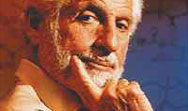

Shebang:
Let's talk initially, please, about two of your big scientific achievements.
Djerassi:
Sure.
Shebang: To begin with, the achievement that is
always mentioned in connection with you is the first synthesis of the
steroid oral contraceptive.
Djerassi: Yes. Well, we're now talking about work that was done
49 years ago. This was the early fifties. And I am now just about the
only survivor. The only reason for it is because I was very young, 26
or 27 years old when this went on, whereas most of the people - others
who were working in the field - were the usual middle-aged people, and
they are now long dead. They would now be over 100 years old. And one
has the tendency to romanticize. I mean the general public, too, and people
who have interviewed me over the decades. There is always the thought
somehow that it was some Eureka affair. You know, you're sitting
around and suddenly, Oh My God, this is it! This is the solution to the
world's problems of contraception, to the world population problem, the
population explosion. It doesn't work like that.
Shebang: Right.
Djerassi: First you want to remember that people have a tendency
always to have one person who is the 'Father of' - the Father of Penicillin,
the Father of the Pill, the Father of the country, the Father of this
and that. You really won't create anything by being only the Father. Clearly,
to create any thing, any "living" thing, you need a Mother, you need a
Father and you need a Midwife. And that metaphor, if you wish, is an accurate
description, it's completely relevant to this Pill, because the chemist
in my book - not just Carl Djerassi, the chemist - the chemist is invariably
the Mother of a medical inventiondrug, an invention that is relevant to
medicine. Invariably, because nothing can be done until the chemical entity
has been created. In other words, consider it "the egg." And the biologist
in my opinion is invariably the Father, with the initial biological experiments
being the sperm that float around until one fertilizes the egg.. And the
clinician of course is then the Midwife.
Shebang: The chemist, like Necessity, is the Mother....
Djerassi: Yes. The chemist is always the mother of the invention,
and it could be a male mother. The biologist is always the father and
it could be a female father.
CARL
DJERASSI'S STORY OF THE PILL - AS TOLD TO SHEBANG
Mexico
I am a chemist, I am not a biologist. And in fact it so happened a biologists
didn't even work in our lab. It so happened our work was done in Mexico.
I went to Mexico City; I was in charge of the chemical research of a small
company called Syntex. Mexico was a country in which there was no research
being done at that time, and yet this became a real powerhouse of steroid
chemical research. Now steroid chemistry was my specialty. That's what
I got my degree in, that's what I had worked on for five years in the
States.
Progesterone
What you now want to remember is that there is a contraceptive in Nature
and that is progesterone, one of the natural female sex hormones. Women
do not get pregnant during pregnancy. That is the only time when they
don't cannot get pregnant. Then They secrete progesterone all the time,
and one of the functions of progesterone - it has many others, several
others - is the prevention of further additional ovulation because no
new eggs are being produced at the time. If no eggs are produced you can't
have any babies.
History
An Austrian endocrinologist, Ludwig Haberlandt, already recognized this
in the 1920's before progesterone was even known as a compound. It had
not been isolated yet but one knew that such a substance presumably existed
in the corpus nutrium luteum and that it could fulfill that function.
He postulated: why not use the corpus nutrium luteum extract as a contraceptivehormonal
sterilant. Well that was too early, and it was not really realistic for
various reasons, including that it was not orally active. But the idea
was there.
Used for Fertility!
In the 1930's when progesterone was isolated, the chemical structure established,
and it was synthesized, progesterone was then used in medicine, starting
in the late 1930's and it still is to this day - for the treatment of
menstrual disorders and for the treatment of some conditions of infertility.
The other function of progesterone is the maintenance of a the proper
environment in the uterus, so that the embryo can implant and then can
develop eventually into a foetus and then develop into a baby. So we need
progesterone for that as well. There are women who do not produce enough
progesterone and they suffer from habitual abortion because they cannot
carry a baby to term, and this is when progesterone is given to them to
help them through that. So progesterone in the 40s and 50s was used for
the treatment of menstrual disorders, irregular menstruation, painful
menstruation, excessive bleeding and for the treatment of infertility.
It was not active orally; it was given by injection.
Making it
We set out as chemists because we were working in the field of steroid
chemistry and Syntex, the small company where I worked, was the world's
largest producer of progesterone. It produced progesterone by complex
chemical steps from a Mexican plant of the Dioscorea genus, [Said to be
like a yam] which does not contain progesterone it contains another steroid
called diosgenin but through chemical transformations it can be converted
into progesterone We as chemists set out to see whether we could convert
the steroid diosgenin into other steroids, which do not exist in nature,
but which retain the biological activities of progesterone and are also
orally active. In other words, our motivation was to develop an orally
effective replacement for the then existing uses of progesterone. In addition,
one thought at that time, and it was not unreasonable, that progesterone
could also be helpful in the treatment of cervical cancer, a very serious
form of cancer. So there were plenty of incentives to work on that.
Success
And we we succeeded in accomplishing that. And on October 15 ,1951 we
finished the synthesis of a chemical compound that has a long chemical
name, (17a-ethinyl-19-nortestosterone) but a simpler generic name: norethindrone
or in Europe norethisterone. And that is the substance that to this day
is one of the active ingredients of the oral contraceptive that is taken
by millions of women.
Other Pills
And the other oral contraceptives which have been developed since that
time have very minor chemical modifications from those of norethindrone,
and these minor modifications have been prompted primarily by the desire
to circumvent the patent that Syntex had at that time And to establish
their own patent position.. Of course that's now expired - patents are
only good for 17 years. But from a biological - scientific standpoint
you could say that there are six active ingredients even when there are
hundreds of different pills but they are all based on the formulation
of these 6 active ingredients. A chemist would see that they are extremely
close to what we first developed just as the various penicillins now are
chemically close to the original penicillin that Fleming had discovered.
